Identification of Preferential Runoff Belts in Jinan Spring Basin Based on Hydrological Time-Series Correlation
Abstract
:1. Introduction
2. Study Area
3. Data and Methods
3.1. Data
3.2. The Continuous Wavelet Transform (CWT)
3.3. The Cross Wavelet Transforms (XWT)
3.4. Cross Wavelet Phase Angle
3.5. Pearson Correlation Coefficient Method
4. Results
4.1. The XWT of Spring Water Level and Precipitation
4.2. Pearson Correlation Coefficient of Spring Water Level and Precipitation
4.3. The XWT and Correlation Coefficient of Groundwater Level and Precipitation
4.4. Verification Based on Hydrogeological Conditions of Study Area
5. Conclusions
- (1)
- The time-lag of BTS and HHS water level and precipitation within the range is 3–4 months. The results of XWT and Pearson correlation coefficient indicated that Xinglong, Donghongmiao, Qiujiazhuang, Xiying, Yanzishan, and Liubu stations are more likely to be located on preferential runoff belt.
- (2)
- Based on the hydrogeological conditions of the Jinan Spring Basin, the approximate location of the preferential runoff belt was identified: the Liubu-Qiujiazhuang-Xinglong belt along the Qianfoshan Fault, the Xiying-Yanzishan belt on the west side of the Qianfoshan Fault, and the Donghongmiao- northern part of the Qianfoshan Fault-BTS belt.
- (3)
- The time-lag and correlation between groundwater level and precipitation in the Jinan Spring Basin are still not clear, the mechanism of the quick response of groundwater level to precipitation is still obscure. Further study is necessary to use more appropriate mathematical methods and more hydrological time-series data to identify the location of preferential runoff belt, and to conduct more fundamental theory research on this subject.
Author Contributions
Funding
Institutional Review Board Statement
Informed Consent Statement
Data Availability Statement
Acknowledgments
Conflicts of Interest
References
- Duran, L.; Massei, N.; Lecoq, N.; Fournier, M.; Labat, D. Analyzing multi-scale hydrodynamic processes in karst with a coupled conceptual modeling and signal decomposition approach. J. Hydrol. 2020, 583, 124625. [Google Scholar] [CrossRef]
- Zhang, Z.X.; Wang, W.P.; Qu, S.S.; Huang, Q.; Liu, S.; Xu, Q.Y.; Ni, L.D. A New Perspective to Explore the Hydraulic Connectivity of Karst Aquifer System in Jinan Spring Catchment, China. Water 2018, 10, 1368. [Google Scholar] [CrossRef] [Green Version]
- Zhu, H.H.; Xing, L.T.; Meng, Q.H.; Xing, X.R.; Peng, Y.M.; Li, C.S.; Li, H.; Yang, L.Z. Water Recharge of Jinan Karst Springs, Shandong, China. Water 2020, 12, 694. [Google Scholar] [CrossRef] [Green Version]
- Qian, J.Z.; Zhan, H.B.; Wu, Y.F.; Li, F.L.; Wang, J.Q. Fractured-karst spring-flow protections: A case study in Jinan, China. Hydrogeol. J. 2006, 14, 1192–1205. [Google Scholar] [CrossRef]
- Yu, M.; Xing, L.T.; Wu, J.C.; Hou, Y.S.; Zhu, H.H.; Peng, Y.M.; Li, G. Study of large karst springs using the time series fractal method in Jinan. Actag Eologica Sin. 2020, 94, 2509. (In Chinese) [Google Scholar]
- Zhou, J.; Xing, L.T.; Teng, Z.X.; Wang, L.Y. Study on the threshold of main factors restricting Jinan large karst springs spewing. J. East China Norm. Univ. (Nat. Sci.) 2015, 2015, 146–156. (In Chinese) [Google Scholar]
- Wang, M.M.; Shu, L.C.; Ji, Y.F.; Tao, Y.F.; Dong, G.M.; Liu, L.H. Causes of spring’s of flux attenuation and simulation of spring’s regime—A case in Jinan karst spring area. Carsologica Sin. 2008, 27, 19–23. (In Chinese) [Google Scholar]
- Xing, L.T.; Huang, L.X.; Chi, G.Y.; Yang, L.Z.; Li, C.S.; Hou, X.Y. A Dynamic Study of a Karst Spring Based on Wavelet Analysis and the Mann-Kendall Trend Test. Water 2018, 10, 698. [Google Scholar] [CrossRef] [Green Version]
- Ni, H.X.; Shu, L.C.; Han, G.; Zhang, M.Q.; Wang, X.; Wang, X.B.; Yu, Y.F.; Opoku, P.A. Impact of urbanization on precipitation infiltration recharge in Jinan Spring Basin. S.–N. Water Transf. Water Sci. Technol. 2020, 18, 64–70. (In Chinese) [Google Scholar]
- Qi, X.F.; Wang, Y.S.; Yang, L.Z.; Liu, Z.Y.; Li, W.P. Time lag variance of groundwater level response to precipitation of Jinan karst spring watershed in recent 50 years. Carsol. Sin. 2016, 35, 384–393. (In Chinese) [Google Scholar]
- An, L.X.; Ren, X.Y.; Hao, Y.H.; Yen, T.Q.; Zhang, B.J. Utilizing Precipitation and Spring Discharge Data to Identify Groundwater Quick Flow Belts in a Karst Spring Catchment. J. Hydrometeorol. 2019, 20, 2057–2068. [Google Scholar] [CrossRef]
- Francesco, F.; Francesco, M.G. Karst Spring Discharges Analysis in Relation to Drought Periods, Using the SPI. Water Resour. Manag. 2010, 24, 1867–1884. [Google Scholar]
- Pardo Igúzquiza, E.; Dowd, P.A.; Xu, C.S.; Durán-Valsero, J.J. Stochastic simulation of karst conduit networks. Adv. Water Resour. 2012, 35, 141–150. [Google Scholar] [CrossRef]
- Atkinson, T.C. Diffuse flow and conduit flow in limestone terrain in Mendip Hills, Somerset (Great Britain). J. Hydrol. 1977, 35, 100. [Google Scholar] [CrossRef]
- Xing, L.T.; Li, C.S.; Zhou, J.; Song, G.Z.; Xing, X.R. The Characteristics of Karst Channel in the Spring of Ji’nan Spring Region. Sci. Technol. Eng. 2017, 17, 57–65. (In Chinese) [Google Scholar]
- Zhu, H.X.; Xing, L.T.; Xiang, H.; Chi, G.Y.; Hou, X.Y. Application of tracer test in the study of preferential runoff path of Ji’nan spring group. Ground Water 2017, 39, 5–7. (In Chinese) [Google Scholar]
- Hartmann, A.; Goldscheider, N.; Wagener, T.; Lange, J.; Weiler, M. Karst water resources in a changing world: Review of hydrological modeling approaches. Rev. Geophys. 2014, 52, 218–242. [Google Scholar] [CrossRef]
- Hu, C.H.; Hao, Y.H.; Yeh, T.C.J.; Pang, B.; Wu, Z.N. Simulation of spring flows from a karst aquifer with an artificial neural network. Hydrol. Process. 2008, 22, 596–604. [Google Scholar] [CrossRef]
- Labat, D.; Ababou, R.; Mangin, A. Rainfall–runoff relations for karstic springs. Part I: Convolution and spectral analyses. J. Hydrol. 2000, 238, 123–148. [Google Scholar] [CrossRef]
- Labat, D. Cross wavelet analyses of annual continental freshwater discharge and selected climate indices. J. Hydrol. 2010, 385, 269–278. [Google Scholar] [CrossRef]
- Labat, D. Wavelet analysis of the annual discharge records of the world’s largest rivers. Adv. Water Resour. 2008, 31, 109–117. [Google Scholar] [CrossRef]
- Szolgayova, E.; Parajka, J.; Bloschl, G.; Bucher, C. Long term variability of the Danube River flow and its relation to precipitation and air temperature. J. Hydrol. 2014, 519, 871–880. [Google Scholar] [CrossRef]
- Rashid, M.M.; Beecham, S.; Chowdhury, R.K. Assessment of trends in point rainfall using Continuous Wavelet Transforms. Adv. Water Resour. 2015, 82, 1–15. [Google Scholar] [CrossRef]
- Grinsted, A.; Moore, J.C.; Jevrejeva, S. Application of the cross wavelet transform and wavelet coherence to geophysical time series. Nonlinear Proc. Geoph. 2004, 11, 561–566. [Google Scholar] [CrossRef]
- Wu, C.C.; Zhang, X.Q.; Wang, W.J.; Lu, C.P.; Zhang, Y.; Qin, W.; Tick, G.R.; Liu, B.; Shu, L.C. Groundwater level modeling framework by combining the wavelet transform with a long short-term memory data-driven model. Sci. Total Environ. 2021, 783, 146948. [Google Scholar] [CrossRef]
- Lin, Y.; Qu, P.C.; Lv, H.X.; Wu, Y.Z. Variation characteristics of typical karst springs in the eastern margin of the Taihang Mountains. Carsologica Sin. 2018, 37, 671–679. (In Chinese) [Google Scholar]
- Miao, J.J.; Liu, G.L.; Cao, B.B.; Hao, Y.H.; Yen, T.Q. Identification of Strong Karst Groundwater Runoff Belt by Cross Wavelet Transform. Water Resour. Manag. 2014, 28, 2903–2916. [Google Scholar] [CrossRef]
- Qi, X.F.; Li, W.P.; Li, H.T.; Yang, L.Z. Teleconnections between groundwater levels, precipitation, air temperature of the Jinan karst springs watershed and large scale climatic patterns. Hydrogeol. Eng. Geol. 2015, 42, 18–28. (In Chinese) [Google Scholar]
- Wan, L.; Zhang, X.P.; Ma, Q.; Zhang, J.J.; Ma, T.Y.; Sun, Y.P. Spatiotemporal characteristics of precipitation and extreme events on the Loess Plateau of China between 1957, and 2009. Hydrol. Process 2014, 28, 4971–4983. [Google Scholar] [CrossRef]
- Tabari, H.; Kisi, O.; Ezani, A.; Talaee, P.H. SVM, ANFIS, regression and climate based models for reference evapotranspiration modelling using limited climatic data in a semi-arid highland environment. J. Hydrol. 2012, 444–445, 78–89. [Google Scholar] [CrossRef]
- Bai, Y.; Bezak, N.; Zeng, B.; Li, C.; Sapac, K.; Zhang, J. Daily Runoff Forecasting Using a Cascade Long Short-Term Memory Model that Considers Different Variables. Water Resour. Manag. 2021, 35, 1167–1181. [Google Scholar] [CrossRef]
- Dikbaş, F. A novel two-dimensional correlation coefficient for assessing associations in time series data. Int. J. Climatol. 2017, 37, 4065–4076. [Google Scholar] [CrossRef]
- Wang, J.J.; Xu, Z.X.; Li, P.; Cheng, T.; Su, H. Characteristics and attribution of groundwater depth changes in Jinan City. S.—N. Water Transf. Water Sci. Technol. 2021, 19, 883–893. (In Chinese) [Google Scholar]
- Seung, H.L.; Chang, W.O.; Jung, W.P. The age and geochemistry of the mid-Cretaceous volcanic rocks in the Jinan Basin: Implications for the mid-Cretaceous tectonic environments of the Korean Peninsula and Northeast Asia. Lithos 2020, 358–359, 105383. [Google Scholar]
- Guo, Y.; Qin, D.J.; Li, L.; Sun, J.; Li, F.L.; Huang, J.W. A Complicated Karst Spring System: Identified by Karst Springs Using Water Level, Hydrogeochemical, and Isotopic Data in Jinan, China. Water 2019, 11, 947. [Google Scholar] [CrossRef] [Green Version]
- Wang, J.L.; Jin, M.G.; Lu, G.P.; Zhang, D.L.; Kang, F.X.; Jia, B.J. Investigation of discharge-area groundwaters for recharge source characterization on different scales: The case of Jinan in northern China. Hydrogeol. J. 2016, 24, 1723–1737. [Google Scholar] [CrossRef]
- Kang, F.X.; Jin, M.G.; Qin, P.R. Sustainable yield of a karst aquifer system: A case study of Jinan springs in northern China. Hydrogeol. J. 2011, 19, 851–863. [Google Scholar] [CrossRef]
- Brett, M.T. When is a correlation between non-independent variables “spurious”? Oikos 2004, 105, 647–656. [Google Scholar] [CrossRef]
- Zhang, Z.X.; Liu, Y.; Zhang, F.X. Prediction of groundwater table based on time series models in Baotu Spring of Jinan. J. China Inst. Water Resour. Hydropower Res. 2019, 17, 51–59. (In Chinese) [Google Scholar]
- Gao, Z.J.; Xu, J.X.; Wang, S.C.; Li, C.S.; Han, K.; Li, J.J.; Luo, F.; Ma, H.K. The distribution characteristics and hydrogeological significance of trace elements in karst water, Jinan, China. Earth Sci. Front. 2014, 21, 135–146. (In Chinese) [Google Scholar]
- Hu, J.B.; Liang, H.F.; Li, G.L. Study on the characteristics of karst development in Jinan Spring Basin. China Steel Focus. 2020, 395, 134–150. (In Chinese) [Google Scholar]
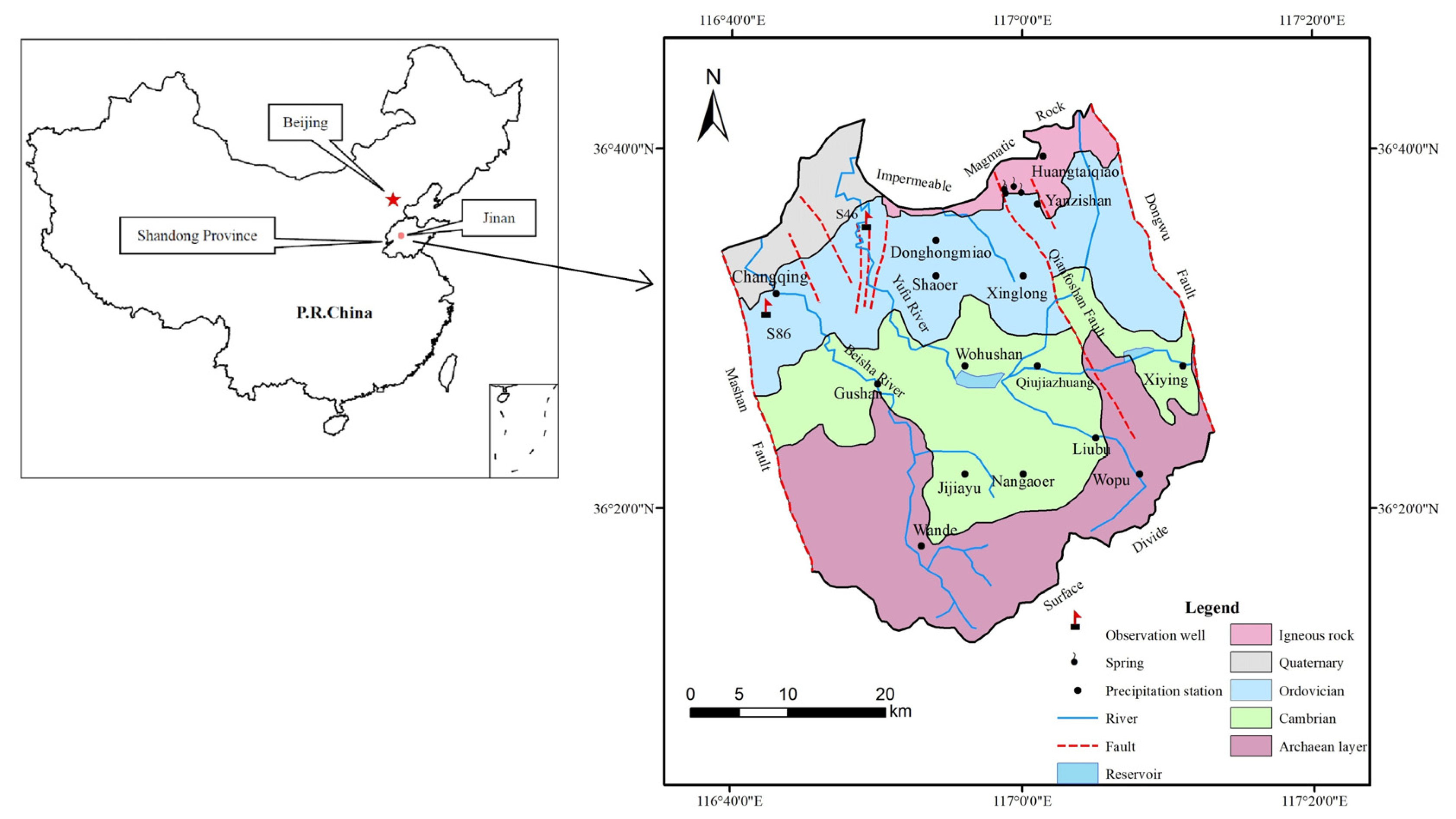

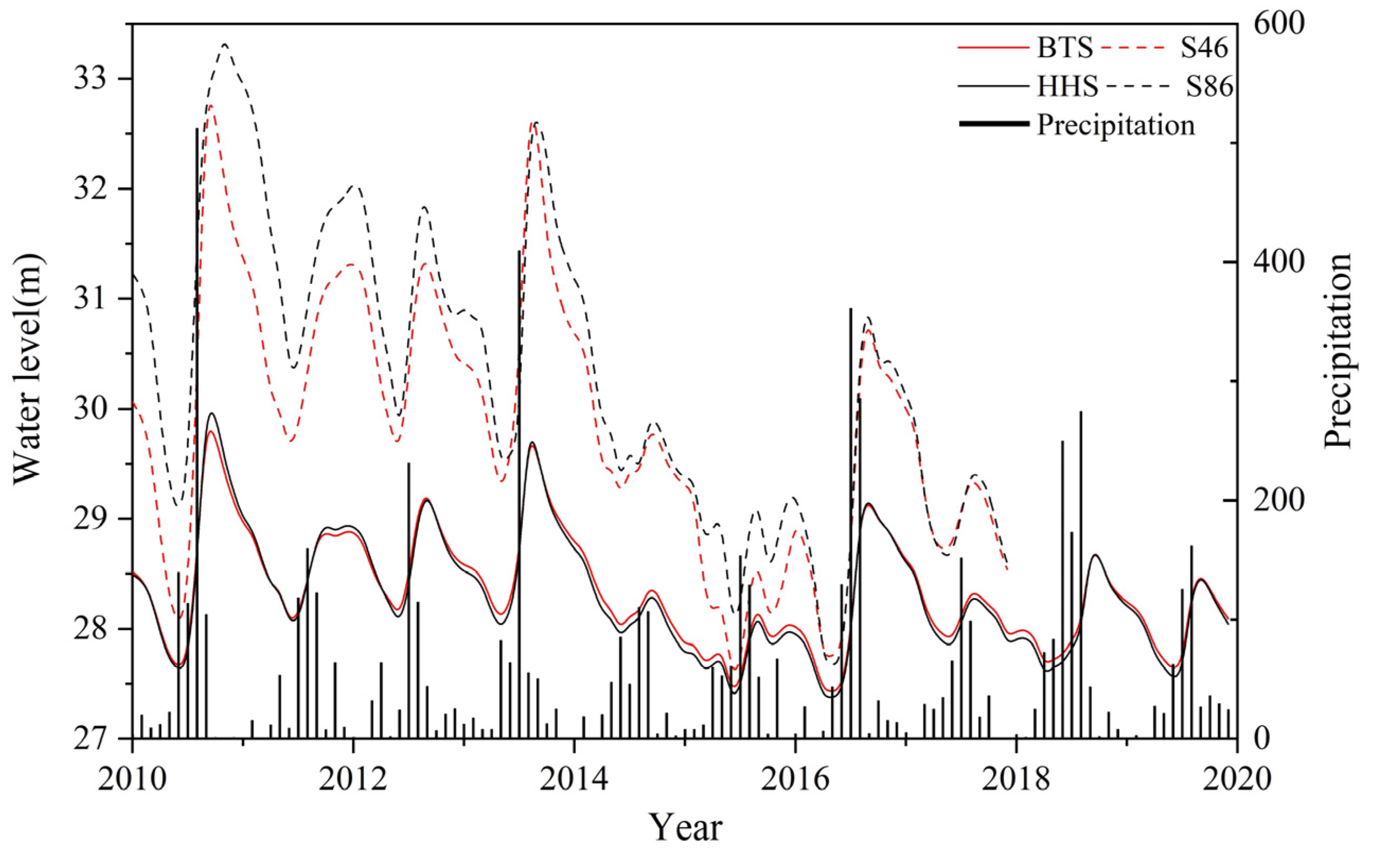
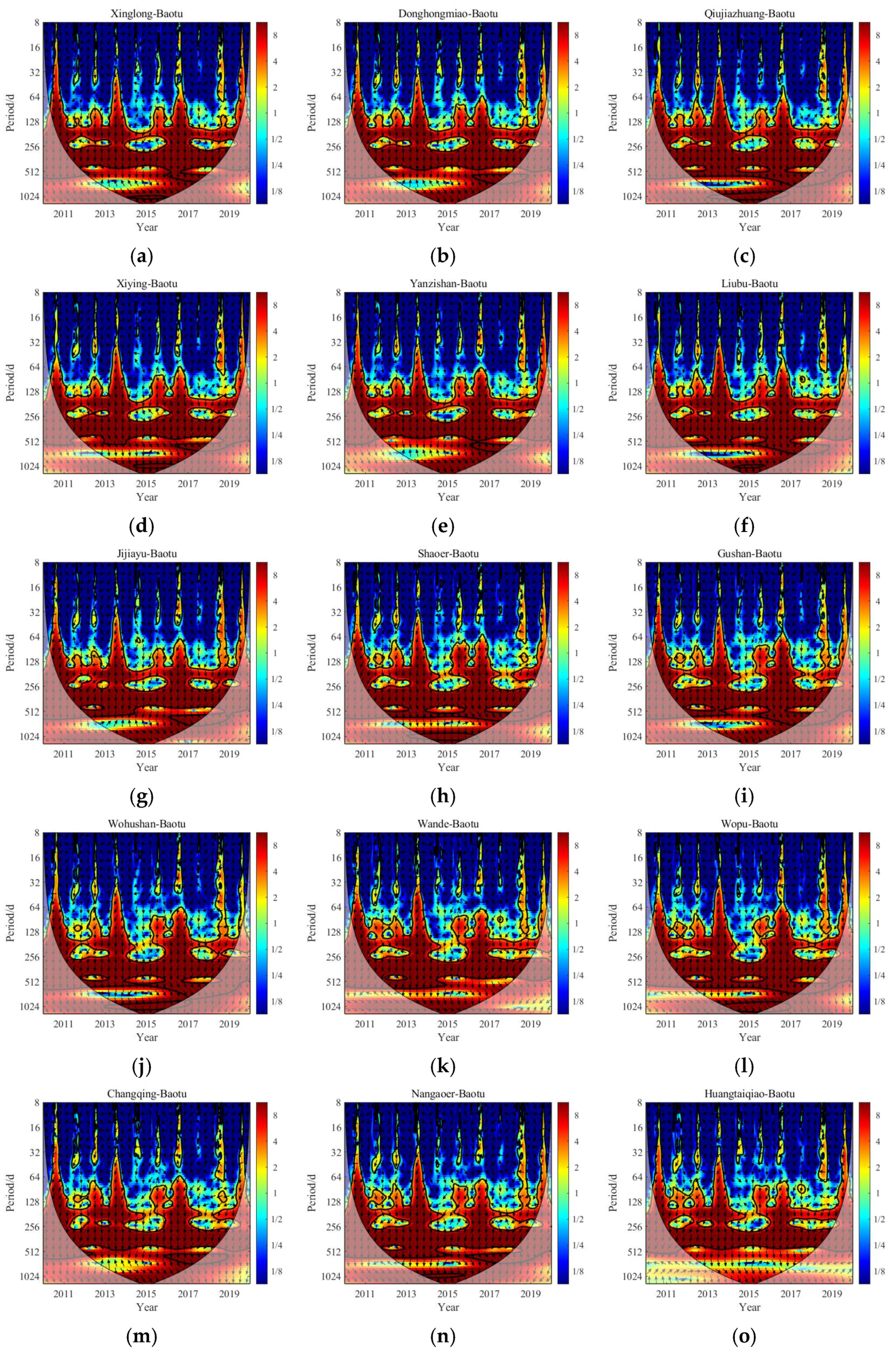
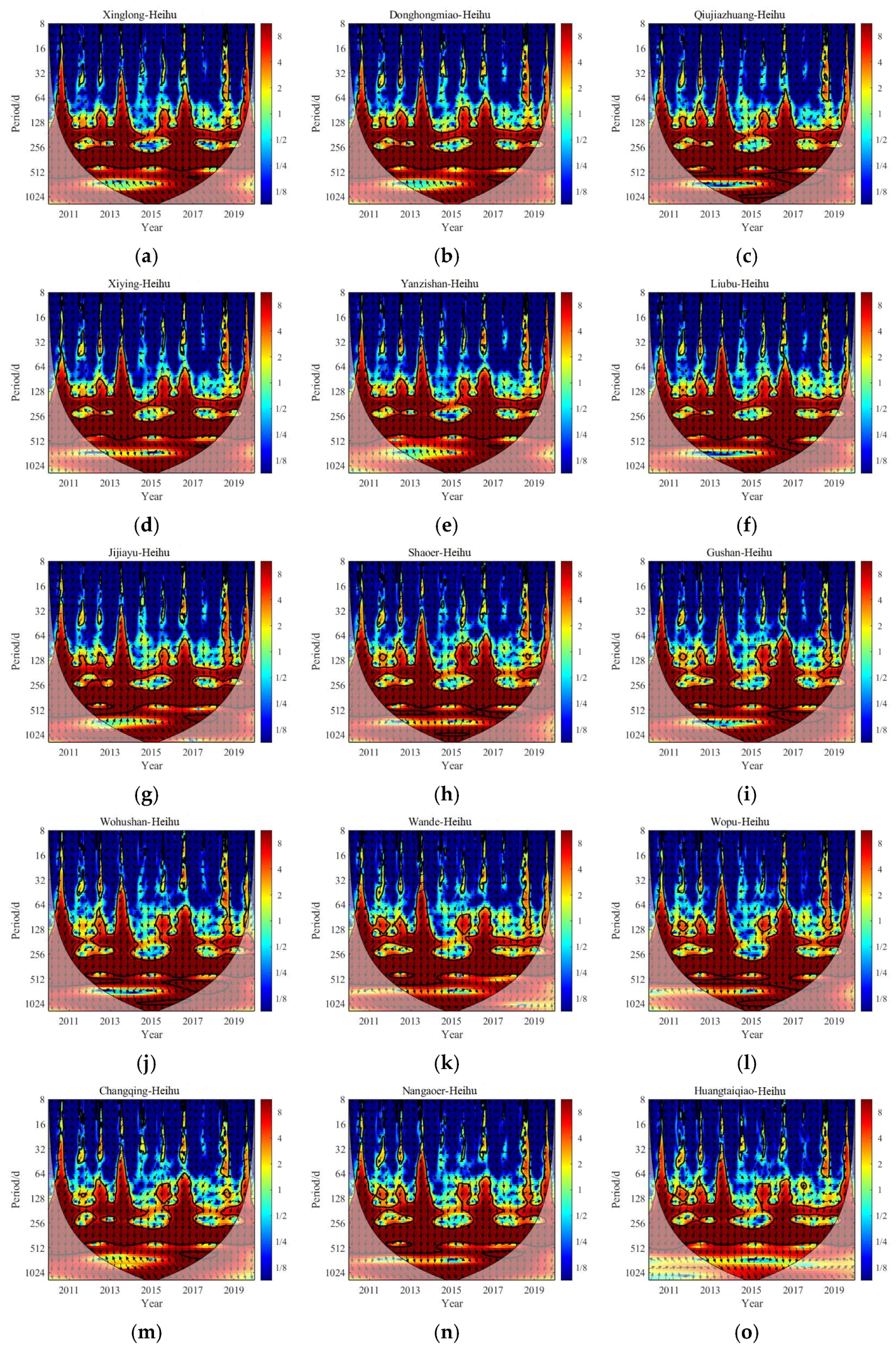
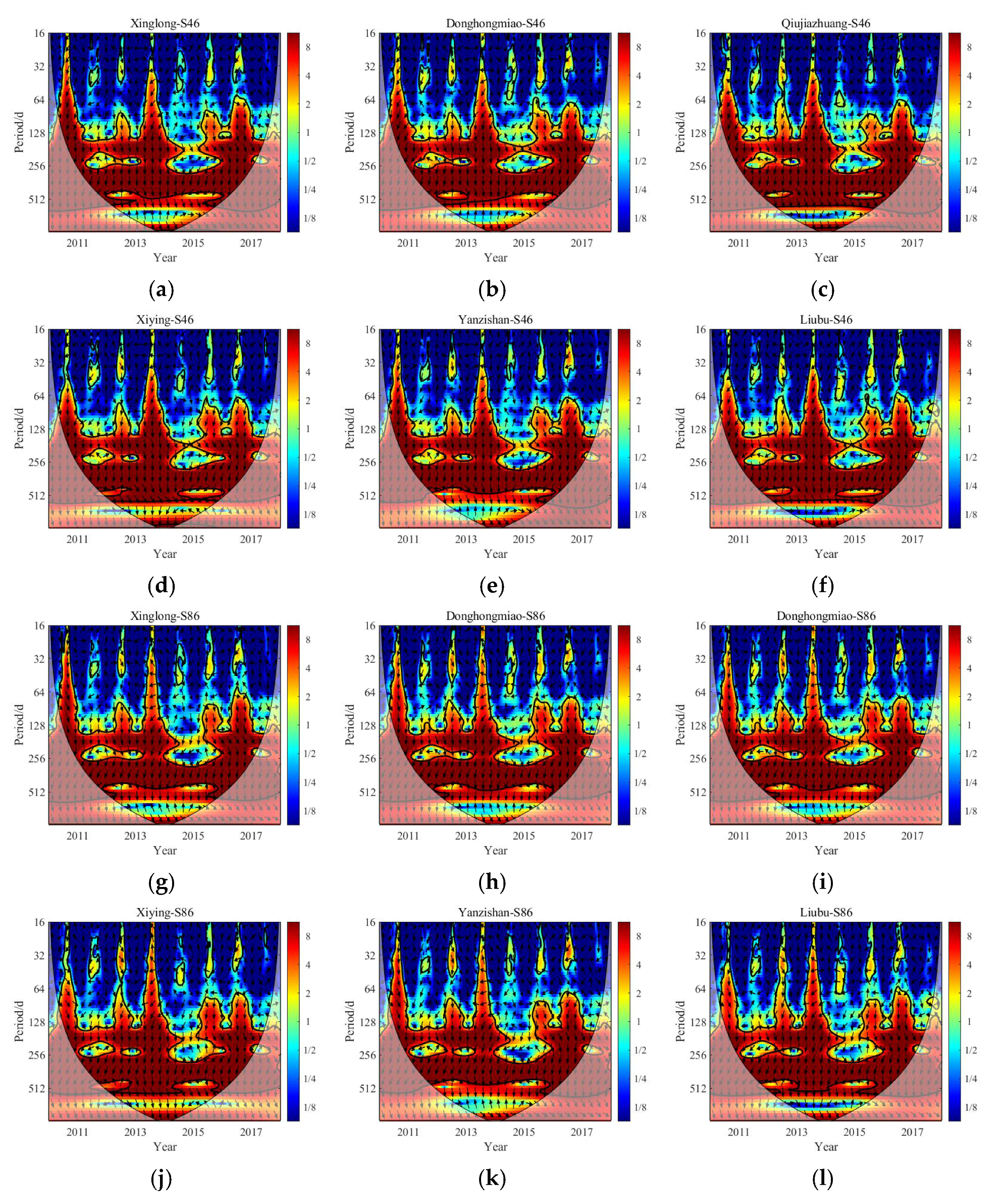
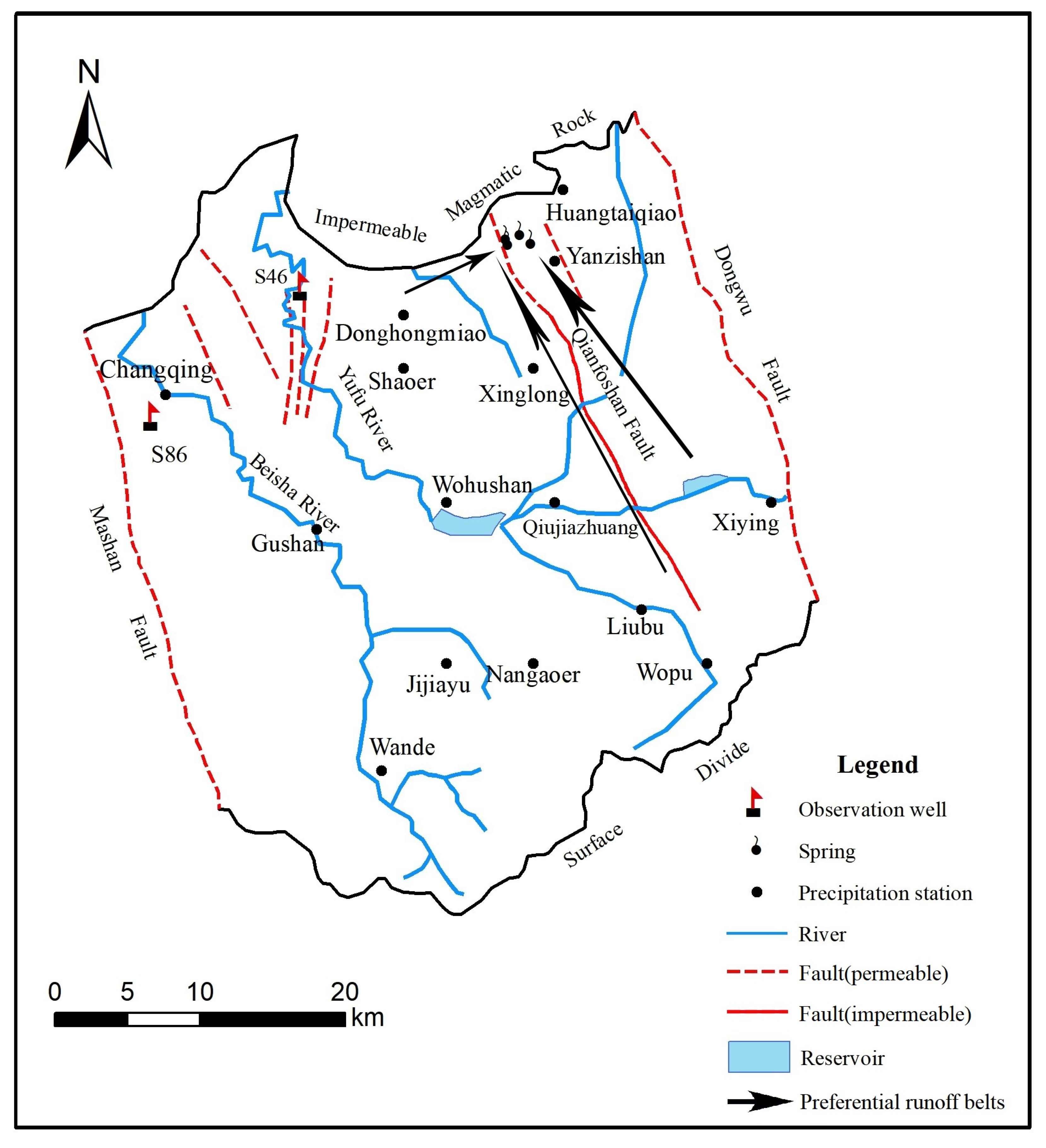
| Station | Annual Average Precipitation/mm | Distance to BTS/km | Distance to HHS/km | Distance to S46/km | Distance to S86/km |
|---|---|---|---|---|---|
| Changqing | 663.70 | 25.75 | 27.24 | 13.69 | 2.42 |
| Huangtaiqiao | 639.10 | 5.52 | 4.69 | 19.58 | 3.83 |
| Donghongmiao | 515.90 | 8.63 | 10.03 | 7.27 | 19.11 |
| Shaoer | 640.42 | 11.11 | 12.26 | 8.71 | 17.95 |
| Xinglong | 572.95 | 8.66 | 8.57 | 16.85 | 26.74 |
| Yanzishan | 538.10 | 3.43 | 2.04 | 17.75 | 30.16 |
| Gushan | 692.29 | 23.59 | 24.57 | 16.11 | 13.54 |
| Qiujiazhuang | 527.85 | 18.02 | 17.89 | 22.62 | 28.43 |
| Wohushan | 677.11 | 18.22 | 18.73 | 17.46 | 21.15 |
| Xiying | 555.90 | 25.41 | 24.36 | 35.49 | 43.19 |
| Jijiayu | 569.40 | 29.13 | 29.48 | 27.27 | 26.21 |
| Liubu | 549.90 | 26.77 | 26.34 | 31.98 | 36.21 |
| Nangaoer | 749.36 | 28.88 | 28.91 | 30.00 | 31.10 |
| Wopu | 731.62 | 31.92 | 31.35 | 37.78 | 41.74 |
| Wande | 626.19 | 37.25 | 37.73 | 33.19 | 28.63 |
| Station | BTS | HHS | Rank | ||
|---|---|---|---|---|---|
| Phase Angle (Rad) | Mean Time-Lag (Day) | Phase Angle (Rad) | Mean Time-Lag (Day) | ||
| Xinglong | 1.61 ± 0.07 | 93.81 ± 4.03 | 1.61 ± 0.08 | 93.79 ± 4.84 | 1 |
| Donghongmiao | 1.62 ± 0.10 | 94.39 ± 5.97 | 1.62 ± 0.11 | 94.37 ± 6.63 | 2 |
| Qiujiazhuang | 1.63 ± 0.10 | 94.49 ± 6.01 | 1.63 ± 0.12 | 94.46 ± 6.71 | 3 |
| Xiying | 1.63 ± 0.10 | 94.61 ± 5.8 | 1.63 ± 0.11 | 94.59 ± 6.41 | 4 |
| Yanzishan | 1.64 ± 0.07 | 95.11 ± 4.23 | 1.64 ± 0.09 | 95.08 ± 5.09 | 5 |
| Liubu | 1.64 ± 0.09 | 95.26 ± 5.24 | 1.64 ± 0.10 | 95.24 ± 5.72 | 6 |
| Jijiayu | 1.65 ± 0.10 | 95.80 ± 5.97 | 1.65 ± 0.12 | 95.78 ± 6.97 | 7 |
| Shaoer | 1.69 ± 0.10 | 98.20 ± 5.67 | 1.69 ± 0.11 | 98.17 ± 6.50 | 8 |
| Gushan | 1.70 ± 0.08 | 98.54 ± 4.48 | 1.70 ± 0.09 | 98.52 ± 4.94 | 9 |
| Wohushan | 1.72 ± 0.08 | 99.7 ± 4.86 | 1.72 ± 0.09 | 99.68 ± 5.45 | 10 |
| Wande | 1.74 ± 0.07 | 101.2 ± 3.89 | 1.74 ± 0.06 | 101.18 ± 3.75 | 11 |
| Wopu | 1.74 ± 0.07 | 101.28 ± 4.00 | 1.74 ± 0.07 | 101.25 ± 4.06 | 12 |
| Changqing | 1.75 ± 0.10 | 101.38 ± 5.58 | 1.74 ± 0.10 | 101.36 ± 5.77 | 13 |
| Nangaoer | 1.75 ± 0.08 | 101.55 ± 4.41 | 1.75 ± 0.08 | 101.53 ± 4.69 | 14 |
| Huangtaiqiao | 1.79 ± 0.07 | 103.76 ± 4.34 | 1.79 ± 0.09 | 103.73 ± 4.97 | 15 |
| Station | BTS | HHS | Rank |
|---|---|---|---|
| Xinglong | 0.1687 | 0.1566 | 1 |
| Donghongmiao | 0.1626 | 0.1507 | 2 |
| Qiujiazhuang | 0.1604 | 0.1478 | 3 |
| Xiying | 0.1467 | 0.1342 | 4 |
| Yanzishan | 0.1463 | 0.1333 | 5 |
| Liubu | 0.1454 | 0.1326 | 6 |
| Jijiayu | 0.1380 | 0.1241 | 7 |
| Shaoer | 0.1284 | 0.1154 | 8 |
| Gushan | 0.1283 | 0.1154 | 9 |
| Wohushan | 0.1268 | 0.1145 | 10 |
| Wande | 0.1235 | 0.1089 | 11 |
| Wopu | 0.1142 | 0.0996 | 12 |
| Changqing | 0.1139 | 0.0978 | 13 |
| Nangaoer | 0.1065 | 0.0928 | 14 |
| Huangtaiqiao | 0.1025 | 0.0878 | 15 |
| Station | Mean Time-Lag | Correlation Coefficient | ||
|---|---|---|---|---|
| S46 | S86 | S46 | S86 | |
| Xinglong | 102.05 ± 5.80 | 112.87 ± 5.80 | 0.0659 | 0.0435 |
| Donghongmiao | 101.66 ± 7.04 | 112.47 ± 6.63 | 0.0526 | 0.0231 |
| Qiujiazhuang | 101.71 ± 6.85 | 112.51 ± 6.69 | 0.0382 | 0.0431 |
| Xiying | 101.97 ± 7.34 | 112.78 ± 6.33 | 0.0537 | 0.0274 |
| Yanzishan | 103.22 ± 5.62 | 114.03 ± 5.98 | 0.0982 | 0.0326 |
| Liubu | 102.80 ± 7.05 | 113.62 ± 5.64 | 0.0584 | 0.0031 |
Publisher’s Note: MDPI stays neutral with regard to jurisdictional claims in published maps and institutional affiliations. |
© 2021 by the authors. Licensee MDPI, Basel, Switzerland. This article is an open access article distributed under the terms and conditions of the Creative Commons Attribution (CC BY) license (https://creativecommons.org/licenses/by/4.0/).
Share and Cite
Niu, S.; Shu, L.; Li, H.; Xiang, H.; Wang, X.; Opoku, P.A.; Li, Y. Identification of Preferential Runoff Belts in Jinan Spring Basin Based on Hydrological Time-Series Correlation. Water 2021, 13, 3255. https://doi.org/10.3390/w13223255
Niu S, Shu L, Li H, Xiang H, Wang X, Opoku PA, Li Y. Identification of Preferential Runoff Belts in Jinan Spring Basin Based on Hydrological Time-Series Correlation. Water. 2021; 13(22):3255. https://doi.org/10.3390/w13223255
Chicago/Turabian StyleNiu, Shuyao, Longcang Shu, Hu Li, Hua Xiang, Xin Wang, Portia Annabelle Opoku, and Yuxi Li. 2021. "Identification of Preferential Runoff Belts in Jinan Spring Basin Based on Hydrological Time-Series Correlation" Water 13, no. 22: 3255. https://doi.org/10.3390/w13223255
APA StyleNiu, S., Shu, L., Li, H., Xiang, H., Wang, X., Opoku, P. A., & Li, Y. (2021). Identification of Preferential Runoff Belts in Jinan Spring Basin Based on Hydrological Time-Series Correlation. Water, 13(22), 3255. https://doi.org/10.3390/w13223255







